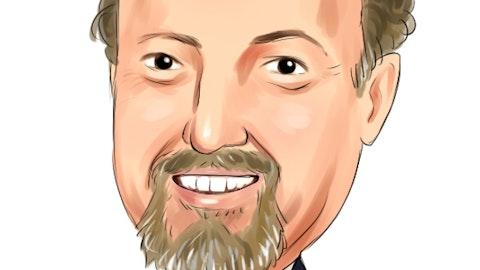So we feel very much confident on this when we’re looking at market by market. Once we are going to go through this year, what will happen is that we expect that we will eat the majority of the inventory or excess inventory that is in the channel, which we, by the way, at least at Q4, estimated about a quarter and a half worth of inventory, excess inventory, sitting in the channel. And what we will see is that as the installation rates are continuing, our under-shipping will go down quarter by quarter until, again, we believe that at the end of the fourth quarter, they will be relatively minimal. So that’s how we view the trends that we see. And again, these are based on discussions that we had with our customers, analysis of historical trends that we saw, seasonality, and market by market also from political and other regulatory environment.
Gross margins in this situation. So when it comes to the gross margin, as I mentioned in the prepared remarks, we expect that once we’re back to $600 million to $650 million of revenues a quarter, we should be at 30% to 32% gross margins, which already include 500 basis points of IRA benefit. And the way to get there is actually twofold. One is of course, is our regular product gross margin that will not change significantly from a cost point of view because of the high inventories. And we actually bake in a small ASP erosion throughout the year. So we expect actually here that the costs will be relatively flat, but prices going a little bit down. But we will see a much more normalized distribution between geographies and between customers, and therefore product margins will go back a little bit.
The second thing is this OCOGS part that we discussed in the past. And here, first of all, the combination of our cost saving measures taken in Q1 when it comes to reduction in force. The closure of Mexico and reduction of China coupled with a lot of work that we did in the quality of product front, starting from changing components in our products to automotive grade components that already shows a lower failure rate and therefore requires lower costs of service of warranty and also lower warranty accruals. And also a little bit of fixes that we did to our existing fleet when it comes to software that also reduces this amount. So we expect to see, even compared to the last time that we were at $600 million, a little bit of a lower fixed cost or OCOGS than we saw before.
So these will be the drivers that we currently see when we aim again being at 30% to 32% at $600 million to $650 million of revenues.
Operator: Thank you, our next question comes from Brian Lee with Goldman Sachs. Hello, Mr. Lee, your line is open.
Brian Lee: Hey, guys. Sorry I was on mute. Thanks for taking the questions. Ronan, I apologize. I’m going to kind of beat the dead horse a little bit here, but a follow-up to Phil’s question. So if we bridge, I know you gave a lot more gross margin clarity than you typically do and it sounds like you’ll do that for the next couple quarters, but it sounds like there’s 900 plus basis points — direct to 900 basis points plus of some of the other COGS. So given where you’re guiding to for Q1, basically like flattish gross margin, you’ve got like 1800 basis points you’ve spoken to. What is the remaining bridge to get to 30% to 32%? I guess that’s where I’m struggling with because there’s — you’ve identified about 20 percentage points.
Where does the other 1,000 basis points come from? And then, just a follow-up to that would be, previously you talked about 500 basis points included for IRA credits That was before the 45X clarity on optimizers being applicable for $0.11 came out in December. So has your view changed there, or did you always embed $0.11 as your base case view, just trying to understand all the puts and takes, but definitely the bridge to the final 30% to 32%. Thanks.
Ronen Faier: Okay. I’ll try at least, Brian. So I’ll start from the second part, which is easy. As we said all along, our assumption was that we will get the $0.11 when it comes to optimizers. And therefore, our 500 basis points is already assuming that we will reach the capacity of inverters that we want to reach, which is 500 megawatts quarter, and certain level of optimizers, which is by the way approximately a million optimizers, a quarter that we expect to have these run rates by the end of Q3. So this is something that was already baked in the same projection that we gave. Now, actually when it comes to the bridge to the 30% to 32%, the two things that you will see as we believe is that first of all, on the product gross margin, you will see very modest increase after Q1.
Again, Q1 is already going to recover a lot of these 930 basis points that we lost. And this is because of the more balanced mix of products that you will see. So actually on the direct gross margin, you do not expect a lot. The thing that you should expect a lot is actually the OCOGS part. And I will do it very simple. Assuming that this number will be just by means of example, $100 million in Q1 divided by $200 million of revenues, this is 50% gross margin impact. Just imagine that now we’re moving into $600 million revenue. You need to take this 50% and divide it by three. And here comes approximately 33% of gross margins that are just added. So that’s the whole story. And to make it even more, I think, easy to explain is that we’ve built our cost structure to support the company that is relatively diverse from a segment point of view, product point of view, serving complicated segments such as C&I, for example.
And that means that we have a relatively heavier cost associated with this kind of a company that we’ve built. Once you’re reducing revenues, Even if you are reducing some of these costs, unless you reduce them exactly by the same level that you reduce your revenues, you see the P&L impact. And when you’re working on such a small revenue basis as you see right now, the impact of gross margin is simply huge. So again, most of the bridge economies of scale even without changing costs. On our fixed cost, most of the bridge going to 30%, 32% will come simply economies of scale.
Brian Lee: Appreciate that. Okay, makes sense. One more from me and I’ll pass it on. And then this one’s maybe a little bit nitpicking but I think last quarter you said you were talking about like a $600 million to $700 million revenue quarterly view at the end of this year kind of when you normalize. Now you’re saying $600 million to $650 million. Is there something embedded in your updated view here in three months, share loss pricing? It just seems like something down ticked a bit on the number and a range that may not have the most precision to begin with. So just trying to understand one, has something changed, and two, how much, I guess, confidence visibility on the $600 million to $650 million not may be changing again going forward.
Ronen Faier: Okay, so I think that when we said it’s $600 million to $700 million, this is, if you remember, based on sell-through level that we saw in Q3, and we assumed that this is the level. Throughout this quarter, we did a lot of work going deeper into our channels to understand what’s happening there, looking at installation rates, dissecting almost every country by the various trends that we see there, and talking, by the way, to a lot of the installers to actually understand exactly what they see as well, which was one of the things that we did a little bit less prior to this period. And we simply were able to get the things a little bit more accurate.
Brian Lee: Understood. All right. I’ll pass it on. Thanks, guys.
Ronen Faier: Thank you.
Operator: Thank you. Our next call — our next question comes from Kashy Harrison with Piper Sandler.
Kashy Harrison: Hi, good afternoon, everyone. Thanks for taking the questions. So just first one for me. Can you provide us with a, maybe a detailed walk on how we get from $500 million of sell-through in 4Q ’23 to the $600 million to $650 million that you’re talking about by the middle of the year? And then can you also give us a sense of what the total dollar of product that you’re attempting to destock from the channel is with as much detail as you can, if possible? And I have a follow-up.
Ronen Faier: So Kashy, first of all, the move of $500 million, [$600 million] (ph) towards the second half of the year is mostly related to seasonality impacts that we see. And again, in some cases, a little bit of analysis of the market. So we went through and looked at how seasonality looked in Europe, by the way, prior to COVID and the war in Ukraine, you wouldn’t believe it, but there were a little bit of a normal years. And when we looked at normal years, we usually saw an increase of about 17%, 20% from Q1 to Q2 and about 15% from Q2 to Q3. And by this, you simply see how the market is behaving. So that’s the first thing that we did. Then we looked into the level that we see right now in Q4 and a little bit into January.
What’s happening in the Netherlands where we know that there was a little bit of a shift in the market. So we simply went one by one, and we looked to the United States and what are the levels that we see here, how the sell-through behaves. And we simply did it one by one. We added to this information coming from other sources. We have a software called Designer that allows installers to design systems with our homegrown product. We’ve looked at how many new designs were made in the past, how many of them were turned into real installations and what is the level that we see right now. So we took this into account. So we actually consolidated various sources of data, historical and current, in order to get to this point. I forgot the second part of your question.
So please, a dollar of inventory that we expect to clear. So in that sense, as we mentioned before, when we see the sell-through of about $500 million in the fourth quarter, as we mentioned, based on this, we assume that there is about a quarter and half worth of excess inventory sitting in the channel. We believe that we’ll clear as mentioned by Zvi, $200 million to $250 million in the first quarter. And from then, it’s going to be gradually declining towards the end of the year. It’s not going to be exactly linear, but it’s going to decline towards the end of the year, we will still see a small amount in Q4. So that’s basically our assumption.
Kashy Harrison: Thank you for all that detail. Really appreciate it. And then my follow-up question. So OpEx, post the tough restructurings, it’s declining to, I think, you said $115 million at midpoint, and that’s down from 12% — that’s down about 12%, I think, from 3Q at $130 million. But if we look at the change in revenues, though, you’re saying sell-through of $600 to $650 million, which is down maybe 34% from the [sell-in $990 million] (ph). And so I guess my question is, what’s behind the reluctance to more aggressively attack the operating cost structure?
Zvi Lando: I think it’s — we use the $600 million to $650 million as an indicator of the trajectory. But we believe it’s a transitional point and we are developing products and Ronen mentioned as well that even in that number of the $600 million to $650 million, we are not including products that we already released and will be generating revenue during 2024 albeit not with the dramatic impact on the overall number of 2024. So this is a transitionary point which we size the company for and are taking the actions in order to be able to grow past that in the midterm based on how we see the industry evolving and how we see our portfolio evolving in order to do this.
Kashy Harrison: Fair enough. Thank you.
Zvi Lando: Thank you.
Operator: Thank you. Our next question comes from Mark Strouse with JPMorgan.
Mark Strouse: Yes, good afternoon. Thanks very much for taking our questions. So a lot of focus on near term, and I appreciate all the numbers. I wanted to go back to the risk, though, I think on the last call, you had talked about kind of trying to protect your ability to — if the market rebounds quickly, you wanted to be in a position to meet that demand and not airship and some of the other things that we’ve dealt with over the last several years. The reduction in force, though, I mean, does that signal any kind of structural changes that you’re looking out kind of over the medium term? And then also kind of as a follow-up, is there any detail that you can provide as far as the reduction in force the impact on resi versus C&I, US versus Europe, kind of by market, by geography, anything you can provide on the reduction in force? Thank you.
Zvi Lando: I think it correlates also to my answer to the previous question. Of course, the reduction in force was not uniform across the departments and the operations of the company. So we were very determined not to impact significantly our R&D capability to maintain strong presence in the regions and in terms of being close to the customers and being able to service them properly in a manufacturing infrastructure that we believe can meet the needs in the near future and be flexible to grow beyond that. So all of that was part of the assessment and the methodology that we implemented. And I would say even on even a more positive note on a net number, more R&D people are working today on new product development and did a year ago, when a big part of them were working on component replacements and adjusting other things related to supply chain constraint.
So in that regard, actually, I think we’re in a better situation today. We did, as mentioned, discontinue some projects in the area of e-mobility. We discontinued some other peripheral projects in the broader solar and energy market and are very, very concentrated on residential and commercial and having an offering of a complete solution from everything that has to do with generation, storage and consumption, everything from inverters, batteries. EV chargers, water heaters, et cetera. So that, we believe, is where we see the future and we’re investing the resources.





